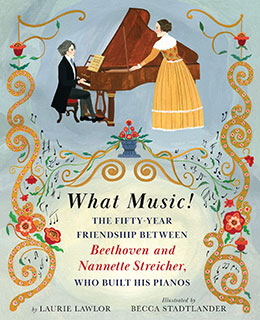The Fifty-Year Friendship between Beethoven and Nannette Streicher, Who Built His Pianos
Book Description
Strings quivered. Notes shimmered. Meet best friends acclaimed composer Ludwig van Beethoven and bold female entrepreneur Nannette Streicher in this lively and lyrical nonfiction picture book.
In a tall, narrow building on a wide avenue
pianos plinked and plunked day and night.
Everyone in quiet Augsburg knew the Stein home.
What music!
In 1787, aspiring yet unknown composer Ludwig van Beethoven arrives at young Nannette Stein’s home. What follows is a decades-long friendship that persists whether life hits a low or high note. Acclaimed nonfiction writer Laurie Lawlor deftly depicts how these two fascinating friends—a composer with hearing loss and a woman who became an innovative piano maker in a time that discouraged female entrepreneurship—fought the odds and worked together in perfect harmony.
The author of picture book biography Fearless World Traveler, Lawlor masterfully uses forgotten historical letters, a glossary, and rich back matter on both friends’ lives and art to introduce readers to the man behind the music, from his loud laughter to his crushing handshake.
Awards and Recognition
- Artwork accepted into the Original Art Show at the Society of Illustrators
Resources
- “New children’s book shines light on Beethoven’s friend Nannette Streicher,” Audrey Bodine, Evanston RoundTable, 10 December 2023
- “Hear the piano thought to be too perfect by Beethoven,” Raina Douris, Kimberly Junod, National Public Radio, 31 August 2022 (You can hear one of Nanette Streicher’s pianos being played!)
Reviews and Comments
Lawlor broadly reconstructs the friendship between composer Ludwig van Beethoven and barrier-breaking businesswoman Nannette Streicher (1769–1833), whose innovative piano design produced instruments capable of withstanding the most tempestuous playing. After meeting as children in her father’s piano shop, Streicher and Beethoven developed a connection despite being “as opposite as fast and slow, loud and soft, high and low.” That connection endured, with Beethoven describing Streicher as “ ‘Beloved Friend,’ the one person who inspired ‘an uncommonly good influence.’ ” Using metaphorical prose (both dreamed that the piano might become “capable of making music as perfect as a palmful of wild raspberries”), Lawlor focuses on the duo’s bond and the context around their professional achievements. Delicate details in Stadtlander’s gouache and colored pencil artwork invite close scrutiny of intricate historical scenes, while vibrant nature imagery conveys the excitement of the pair’s work. Background characters read as white. Thorough back matter includes an author’s note and bibliography. (Publishers Weekly)
“A little-known piano builder had a great impact on Beethoven.
“Who hasn’t heard of Ludwig van Beethoven? By contrast, far fewer know of Nannette Stein Streicher (1769–1833), the German piano builder and proprietor of a successful Viennese piano-construction enterprise and also Beethoven’s lifelong “Beloved Friend.” Well educated and musically gifted, Nannette became involved in her father’s successful piano-building business from an early age. At 18, Nannette met Ludwig, 17, when he visited her home and played for her family. They became fast friends despite their differing personalities and backgrounds. When her father died, Nannette and a younger brother jointly took over her father’s company, since the law forbade a woman to own a company outright. Upon her marriage, Nannette moved the company to Vienna and put her name on what would become the renowned “Nannette Stein Streicher in Vienna” pianos. By then, Ludwig was a celebrated composer-pianist. He required instruments that met his very exacting specifications, and Nannette produced them all. Throughout his life, he played on more than a dozen Streicher pianos, claiming he preferred them over others. This beautifully written, though lengthy, account rightfully brings a lesser-known historical personality to wider attention, but its appeal is somewhat limited. It will be appreciated mostly by adult Beethoven fans and older children, particularly piano students practicing Beethoven pieces. Gorgeous gouache and colored-pencil illustrations bring the detailed period artworks to radiant life. (This book was reviewed digitally.)
Music lovers will rejoice over this worthy title. (author’s note, bibliography, historical figures mentioned in this book, bibliography)” (Kirkus Reviews)
Streicher and Beethoven met as teenagers when he visited her father, Johann Andreas Stein, “the celebrated piano innovator.” Their friendship endured as Streicher would go on to create the unique pianos that showcased Beethoven’s talents, instruments that were “as expressive as a human voice and as varied in tone and timbre as an entire orchestra combined.” Like arrangers orchestrating a duet, Lawlor and Stadtlander intertwine the two biographies, first by presenting a segment of one person’s life, then the corresponding time period of the other’s, and finally the intersection of the two. The chronological pieces, on such topics as childhood, early recognition of their respective talents, and continuing successes and failures, culminate in the initial performance of Beethoven’s Ninth Symphony and his “Ode to Joy,” and the book concludes with each person’s later experiences and their deaths. This pattern allows readers to compare and contrast the two lives, from Beethoven’s difficult childhood with a sick mother and abusive father to Streicher’s unique upbringing with a father who encouraged her formal education but also passed on the details of piano production (which allowed her, uncharacteristically for the times, to operate her own business.) Stadtlander’s gouache and pencil illustrations not only capture the era but also use setting to accentuate character traits; those segments featuring Streicher depict calm routines, while Beethoven’s volatile performances show bright colors and objects visually exploding from his pianos. Appended with informative notes, a bibliography, and documentation. (Betty Carter, The Horn Book Magazine)

written by Laurie Lawlor
illustrated by Becca Stadtlander
Holiday House, 2023
Buy the Book
Laurie introduces us to her book with Becca Stadtlander, What Music! The Fifty-Year Friendship between Beethoven and Nannette Streicher, Who Built His Pianos.

